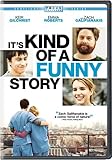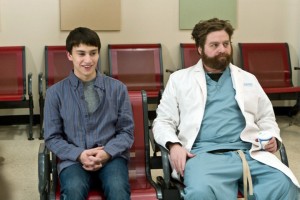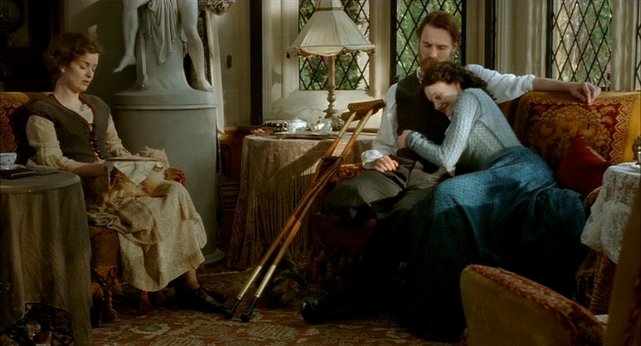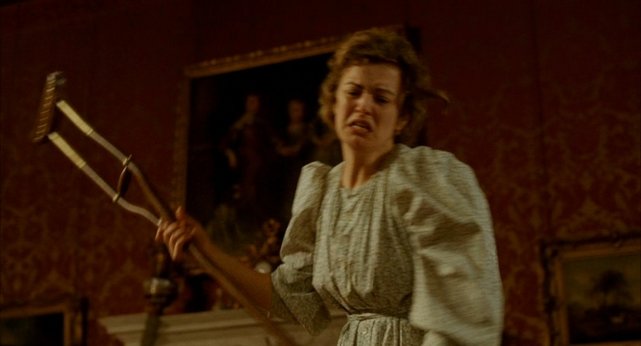[easyazon-image align=”left” asin=”B0043X1FM2″ locale=”us” height=”160″ src=”http://ecx.images-amazon.com/images/I/512WbsNjSBL._SL160_.jpg” width=”114″][easyazon-link asin=”B0043X1FM2″ locale=”us”]The Fisher King[/easyazon-link] includes several brief depictions of physically disabled people, as well as Robin Williams in a not-exactly-clinically-accurate-but-lovable! depiction of a former professor suffering from Post-Traumatic Stress Disorder. (After witnessing the brutal murder of his wife at the hands of a mentally ill man, he spends some time catatonic “in a mental place on Staten Island” and emerges believing he’s a knight on a holy quest.) The gunman, clearly very lonely and seeking advice on talking to a woman, had been goaded into shooting up a popular bar by radio shock-jock protagonist Jack. When he learns of the effect of his bullying, Jack in turn becomes suicidally despondent and attempts to drown himself. In a twist of fate, Jack is introduced to Parry (who is accompanied by a couple other homeless men, one using crutches) and experiences the painful flutterings of an awakening of conscience.
Parry takes him back to the basement he’s been crashing in, where it becomes obvious that he not only has auditory hallucinations but tries to enlist Jack on his quest for the Holy Grail. Jack tries to give him a little money instead, but Parry’s kind “landlord” (who wears an old-fashioned hearing aid in one ear) explains that Parry needs much more than a few dollars to regain what he had lost. Perry tells Jack the story of the Fisher King and the festering wound he received, mirroring the wounds they’ve received in life (and manifest in Jack’s bandaged hand).
Both a motorized wheelchair user and a little person wearing a business suit are milling about in the background when Parry takes Jack to see Lydia, the woman he admires from afar. Parry then shows Jack the “castle” of wealthy philanthropist Landon Carmichael, from whom Parry intends to steal the Grail. (In this high-rent district, there’s another person in a wheelchair, this time an elderly lady being pushed by a uniformed attendant.)
Jack balks at the dangerous plan and suddenly tries to confront Parry with the reality of his identity. Parry is quickly overwhelmed and has a screaming fit, running away to a nearby park where he snaps out of it to come to the aid of an injured and incoherent gay man. Jack and Parry take “Venice” to a crowded, dirty public hospital for medical attention, and Jack’s introduction to the disparities in health care between the rich and the poor.
Jack’s education continues with a trip to Grand Central, where he strikes up a conversation with a disabled veteran begging for spare change. Someone tosses a coin on the floor where the wheelchair-using man can’t reach to pick it up.
“He didn’t even look at you.”
“Well, he’s paying so he don’t have to look.”
“Say, guy goes to work every day eight hours a day, seven days a week. He starts questioning the very fabric of his existence. Then one day about quitting time the boss calls him into the office and says, “Hey Bob, why don’t you come on in here and kiss my ass for me, will you?”
“Well,” he says, “hell with it. I don’t care what happens. I just want to see the expression on his face as I jam this pair of scissors into his arm.”
Then he thinks of me. He says “Wait a minute. I got both my arms, I got both my legs. At least I’m not begging for a living.” Sure enough, Bob’s going to put those scissors down and pucker right up. See, I’m what you call a moral traffic light, really. I’m, like, saying “Red. Go no further. Boop… boop…”
A successful first date with Lydia sets up an internal conflict for Parry, and he has a showdown with The Red Knight, the symbol of his trauma. He becomes stupefied with fear, and is taken back to a mental hospital. Lydia oversees his care, providing cutesy sheets and demanding he be clad in pajamas instead of a hospital gown, but this isn’t enough to wake the prince. Jack presents the Grail and Parry magically wakes up, restored to sanity (and with no side effects from the psychoactive drugs he was probably pumped full of) and ready to lead a chorus of “the bungled and the botched” in song.











